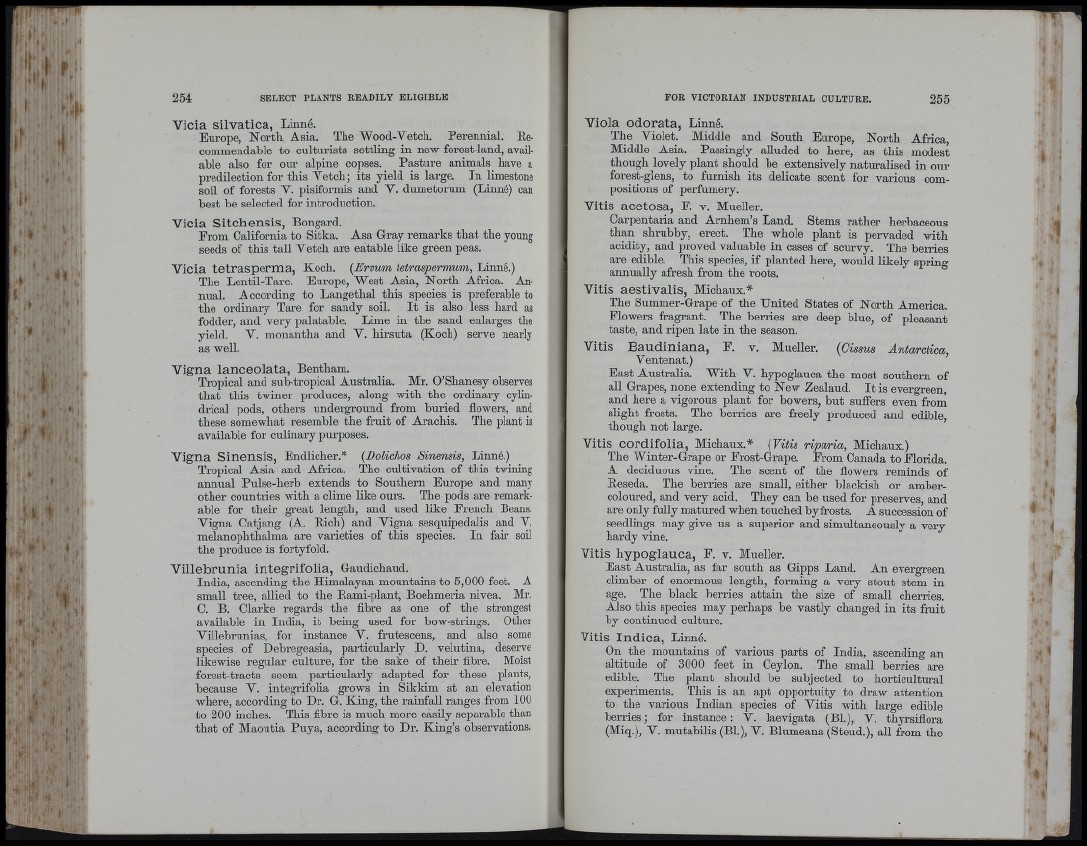
I »
■ i *
Vicia silvática, Linné.
Europe, North Asia. The Wood-Vetch. Perennial. Re-
commendable to culturists settling in new forest-land, available
also for our alpine copses. Pasture animals have a
predilection for this Vetch; its yield is large. In limestone
soil of forests V. pisiformis and V. dumetorum (Linné) can
best be selected for introduction.
Vicia Sitchensis, Bongard.
Erom California to Sitka. Asa Gray remarks that the young
seeds of this tall Vetch are eatable like green peas.
Vicia tetrasperma, Koch. (Ervum tetraspermum, Linné.)
The Lentil-Tare. Europe, West Asia, North Africa. Annual.
According to Langethal this species is preferable to
the ordinary Tare for sandy soil. I t is also less hard as
fodder, and very palatable. Lime in the sand enlarges the
yield. V. monantha and V. hirsuta (Koch) serve nearly
as well.
Vigna lanceolata, Bentham.
Tropical and sub-tropical Australia. Mr. O’Shanesy observes
th a t this twiner produces, along with the ordinary cylindrical
pods, others underground from buried flowers, and
these somewhat resemble the fruit of Arachis. The plant is
available for culinary purposes.
Vigna Sinensis, Endlicher.* (Dolichos Sinensis, Linné.)
Tropical Asia and Africa. The cultivation of this twinhig
annual Pulse-herb extends to Southern Europe and many
other countries with a clime like ours. The pods are remarkable
for their great length, and used like French Beans.
Vigna Catjang (A. Rich) and Vigna sesquipedalis and V.
melanophthalma are varieties of this species. In fair soil
the pi’oduce is fortyfold.
Villebrunia integrifolia, Gaudichaud.
India, ascending the Himalayan mountains to 5,000 feet. A
small tree, allied to the Rami-plant, Boehmeria nivea. Mr.
C. B. Clarke regards the fibre as one of the strongest
available in India, it being used for bow-strings. Other
Villebrunias, for instance V. frutescens, and also some
species of Debregeasia, particularly D. velutina, deserve
likewise regular culture, for the sake of their fibre. Moist
forest-tracts seem particularly adapted for these plants,
because V. integrifolia grows in Sikkim at an elevation
where, according to Dr. O. King, the rainfall ranges from 100
to 200 inches. This fibre is much more easily separable than
th a t of Maoutia Puya, according to Dr. King’s observations.
Viola odorata, Linné.
The Violet. Middle and South Europe, North Africa,
Middle Asia. Passingly alluded to here, as this modest
though lovely plant should he extensively naturalised in our
forest-glens, to furnish its delicate scent for various compositions
of perfumery.
Vitis acetosa, F. v. Mueller.
Carpentaria and Arnhem’s Land. Stems rather herbaceous
than shrubby, erect. The whole plant is pervaded with
a c i d i t y , and proved valuable in cases of scurvy. The berries
are edible. This species, if planted here, would likely spring
annually afresh from the roots.
Vitis aestivalis, Michaux.*
The Summer-Orape of the United States of North America.
Flowers fragrant. The berries are deep blue, of pleasant
taste, and ripen late in the season.
Vitis Baudiniana, E. v. Mueller. (Cissus Antarctica,
Ventenat.)
East Australia. With V. hypoglanca the most southern of
all Grapes, none extending to New Zealand. I t is evergreen,
and here a vigorous plant for bowers, but sufiers even from
slight frosts. The berries are freely produced and edible,
though not large.
V itis cordifolia, Michaux.* (Yitis riparia, Michaux.)
The Winter-Orape or Erost-Grape. Erom Canada to Florida.
A deciduous vine. The scent of the flowers reminds of
Reseda. The berries are small, either blackish or apiber-
colonred, and very acid. They can be used for preserves, and
are only fully matured when touched by frosts. A succession of
seedlings may give us a superior and simultaneously a very
hardy vine.
Vitis hypoglauca, E. v. Mueller.
East Australia, as far south as Gipps Land. An evergreen
climber of enormous length, forming a very stout stem in
age. The black berries attain the size of small cherries.
Also this species may perhaps be vastly changed in its fruit
by continued culture.
Vitis Indica, Linné.
On the mountains of various parts of India, ascending an
altitude of 3000 feet in Ceylon. The small berries are
edible. The plant should be subjected to horticultural
experiments. This is an apt opportuity to draw attention
to the various Indian species of Vitis with large edible
berries ; for instance : V. laevigata (BL), V. thyrsiflora
(Miq.), V. mutabilis (Bl.), V. Blumeana (Steud.), all from the
I '
I
{